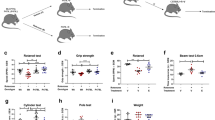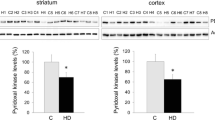Abstract
The carnitine palmitoyl transferase (CPT) system is a multiprotein complex with catalytic activity localized within a core represented by CPT1 and CPT2 in the outer and inner membrane of the mitochondria, respectively. Two proteins, the acyl-CoA synthase and a translocase also form part of this system. This system is crucial for the mitochondrial beta-oxidation of long-chain fatty acids. CPT1 has two well-known isoforms, CPT1a and CPT1b. CPT1a is the hepatic isoform and CPT1b is typically muscular; both are normally utilized by the organism for metabolic processes throughout the body. There is a strong evidence for their involvement in various disease states, e.g., metabolic syndrome, cardiovascular diseases, and in diabetes mellitus type 2. Recently, a new, third isoform of CPT was described, CPT1c. This is a neuronal isoform and is prevalently localized in brain regions such as hypothalamus, amygdala, and hippocampus. These brain regions play an important role in control of food intake and neuropsychiatric and neurological diseases. CPT activity has been implicated in several neurological and social diseases mainly related to the alteration of insulin equilibrium in the brain. These pathologies include Parkinson’s disease, Alzheimer’s disease, and schizophrenia. Evolution of both Parkinson’s disease and Alzheimer’s disease is in some way linked to brain insulin and related metabolic dysfunctions with putative links also with the diabetes type 2. Studies show that in the CNS, CPT1c affects ceramide levels, endocannabionoids, and oxidative processes and may play an important role in various brain functions such as learning.





Similar content being viewed by others
References
Virmani A, Ali SF, Binienda ZK (2010) Neuroprotective strategies in drug abuse-evoked encephalopathy. Ann N Y Acad Sci 1199:52–68
Virmani MA, Bisselli R, Spadoni A, Rossi S, Corsico N et al (1995) Protective actions of L-carnitine and acetyl-L-carnitine on the neurotoxicity evoked by mitochondrial uncoupling or inhibitors. Pharmacol Res 32:383–389
Cantó C, Auwerx J (2011) Calorie restriction: is AMPK a key sensor and effector? Physiology (Bethesda) 26:214–224
Palacios HH, Yendluri BB, Parvathaneni K, Shadlinski VB, Obrenovich ME et al (2011) Mitochondrion-specific antioxidants as drug treatments for Alzheimer disease. CNS Neurol Disord Drug Targets 10:149–162
Hernández-Aguilera A, Rull A, Rodríguez-Gallego E, Riera-Borrull M, Luciano-Mateo F et al (2013) Mitochondrial dysfunction: a basic mechanism in inflammation-related non-communicable diseases and therapeutic opportunities. Mediat Inflamm 2013:135698
Price NL, Gomes AP, Ling AJ, Duarte FV, Martin-Montalvo A et al (2012) SIRT1 is required for AMPK activation and the beneficial effects of resveratrol on mitochondrial function. Cell Metab 15:675–690
Song S, Zhang Y, Ma K, Jackson-Hayes L, Lavrentyev EN et al (2004) Peroxisomal proliferator activated receptor gamma coactivator (PGC-1alpha) stimulates carnitine palmitoyltransferase I (CPT-Ialpha) through the first intron. Biochim Biophys Acta 1679:164–173
Schreurs M, Kuipers F, van der Leij FR (2010) Regulatory enzymes of mitochondrial beta-oxidation as targets for treatment of the metabolic syndrome. Obes Rev 11:380–388
van der Leij FR, Cox KB, Jackson VN, Huijkman NC, Bartelds B et al (2002) Structural and functional genomics of the CPT1B gene for muscle-type carnitine palmitoyltransferase I in mammals. J Biol Chem 277:26994–27005
Price N, van der Leij F, Jackson V, Corstorphine C, Thomson R et al (2002) A novel brain-expressed protein related to carnitine palmitoyltransferase I. Genomics 80:433–442
Wolfgang MJ, Kurama T, Dai Y, Suwa A, Asaumi M et al (2006) The brain specific carnitine palmitoyltransferase-1c regulates energy homeostasis. Proc Natl Acad Sci U S A 103:7282–7287
McGarry JD, Brown NF (1997) The mitochondrial carnitine palmitoyltransferase system. From concept to molecular analysis. Eur J Biochem 244:1–14
van der Leij FR, Huijkman NC, Boomsma C, Kuipers JR, Bartelds B (2000) Genomics of the human carnitine acyltransferase genes. Mol Genet Metab 71:139–153
Woldegiorgis G, Dai J, Arvidson D (2005) Structure-function studies with the mitochondrial carnitine palmitoyltransferases I and II. Monatsh Chem 136:1325–1340
Virmani A, Binienda Z (2004) Role of carnitine esters in brain neuropathology. Mol Asp Med 25:533–549
Virmani MA, Rossi S, Conti R, Spadoni A, Arrigoni-Martelli E et al (1996) Structural, metabolic and ionic requirements for the uptake of L-carnitine by primary rat cortical cells. Pharmacol Res 33:19–27
Fritz I (1955) The effect of muscle extracts on the oxidation of palmitic acid by liver slices and homogenates. Acta Physiol Scand 34:367–385
Fritz IB, Yue KT (1963) Long-chain carnitine acyltransferase and the role of acylcarnitine derivatives in the catalytic increase of fatty acid oxidation induced by carnitine. J Lipid Res 4:279–288
Frohnert BI, Jacobs DR Jr, Steinberger J, Moran A, Steffen LM et al (2013) Relation between serum free fatty acids and adiposity, insulin resistance, and cardiovascular risk factors from adolescence to adulthood. Diabetes 62:3163–3169
Cascio G, Schiera G, Di Liegro I (2012) Dietary fatty acids in metabolic syndrome, diabetes and cardiovascular diseases. Curr Diabetes Rev 8:2–17
López M, Lage R, Saha AK, Pérez-Tilve D, Vázquez MJ et al (2008) Hypothalamic fatty acid metabolism mediates the orexigenic action of ghrelin. Cell Metab 7:389–399
López M, Lelliott CJ, Vidal-Puig A (2007) Hypothalamic fatty acid metabolism: a housekeeping pathway that regulates food intake. Bioessays 29:248–261
Kerner J, Hoppel C (2000) Fatty acid import into mitochondria. Biochim Biophys Acta 1486:1–17
Steiber A, Kerner J, Hoppel CL (2004) Carnitine: a nutritional, biosynthetic, and functional perspective. Mol Asp Med 25:455–473
Sierra AY, Gratacós E, Carrasco P, Clotet J, Ureña J et al (2008) CPT1c is localized in endoplasmic reticulum of neurons and has carnitine palmitoyltransferase activity. J Biol Chem 283:6878–6885
Dai Y, Wolfgang MJ, Cha SH, Lane MD (2007) Localization and effect of ectopic expression of CPT1c in CNS feeding centers. Biochem Biophys Res Commun 359:469–474
Gao XF, Chen W, Kong XP, Xu AM, Wang ZG (2009) Enhanced susceptibility of Cpt1c knockout mice to glucose intolerance induced by a high-fat diet involves elevated hepatic gluconeogenesis and decreased skeletal muscle glucose uptake. Diabetologia 52:912–920
Wolfgang MJ, Cha SH, Millington DS, Cline G, Shulman GI et al (2008) Brain specific carnitine palmitoyl-transferase-1c: role in CNS fatty acid metabolism, food intake, and body weight. J Neurochem 105:1550–1559
Wolfgang MJ, Lane MD (2006) The role of hypothalamic malonyl-CoA in energy homeostasis. J Biol Chem 281:37265–37269
Minokoshi Y, Alquier T, Furukawa N, Kim YB, Lee A et al (2004) AMP-kinase regulates food intake by responding to hormonal and nutrient signals in the hypothalamus. Nature 428:569–574
Mayer CM, Belsham DD (2010) Palmitate attenuates insulin signaling and induces endoplasmic reticulum stress and apoptosis in hypothalamic neurons: rescue of resistance and apoptosis through adenosine 5′ monophosphateactivated protein kinase activation. Endocrinology 151:576–585
Ramírez S, Martins L, Jacas J, Carrasco P, Pozo M (2013) Hypothalamic ceramide levels regulated by CPT1C mediate the orexigenic effect of ghrelin. Diabetes 62:2329–2337
Virmani MA, Conti R, Spadoni A, Rossi S, Arrigoni-Martelli E (1994) L-carnitine uptake into primary rat cortical cultures: interaction with GABA. Brain Res Mol Brain Res 25:105–112
Virmani A, Koverech A (2010) Modulation of carnitine palmitoyltransferase enzyme system by carnitine in cultured rat cortical neurones at different ages of development. Neuroprotective Agents, 10th International Conference on Neuroprotective Agents, Asilomar, California, USA
Arduini A, Denisova N, Virmani A, Avrova N, Federici G et al (1994) Evidence for the involvement of carnitine-dependent long-chain acyltransferases in neuronal triglyceride and phospholipid fatty acid turnover. J Neurochem 62:1530–1538
Penn D, Schmidt-Sommerfeld E, Wolf H (1980) Carnitine deficiency in premature infants receiving total parenteral nutrition. Early Hum Dev 4:23–34
Schulze A, Lindner M, Kohlmüller D, Olgemöller K, Mayatepek E et al (2003) Expanded newborn screening for inborn errors of metabolism by electrospray ionization-tandem mass spectrometry: results, outcome, and implications. Pediatrics 111:1399–1406
Bonnefont JP, Djouadi F, Prip-Buus C, Gobin S, Munnich A et al (2004) Carnitine palmitoyltransferases 1 and 2: biochemical, molecular and medical aspects. Mol Asp Med 25:495–520
Thuillier L, Rostane H, Droin V, Demaugre F, Brivet M et al (2003) Correlation between genotype, metabolic data, and clinical presentation in carnitine palmitoyltransferase 2 (CPT2) deficiency. Hum Mutat 21:493–501
Ohtani Y, Tomoda A, Miike T, Matsukura M, Miyatake M et al (1994) Central nervous system disorders and possible brain type carnitine palmitoyltransferase II deficiency. Brain Dev 16:139–145
Longo N, di San A, Filippo C, Pasquali M (2006) Disorders of carnitine transport and the carnitine cycle. Am J Med Genet C: Semin Med Genet 142C:77–85
de Almeida Rabello Oliveira M, da Rocha AT, de Oliveira SL, de Melo Lucena AL, de Lira CE et al (2008) Effects of short-term and long-term treatment with medium- and long-chain triglycerides ketogenic diet on cortical spreading depression in young rats. Neurosci Lett 434:66–70
Hori T, Fukao T, Kobayashi H, Teramoto T, Takayanagi M et al (2010) Carnitine palmitoyltransferase 2 deficiency: the time-course of blood and urinary acylcarnitine levels during initial L-carnitine supplementation. Tohoku J Exp Med 221:191–195
Washington L, Cook GA, Mansbach CM 2nd (2003) Inhibition of carnitine palmitoyltransferase in the rat small intestine reduces export of triacylglycerol into the lymph. J Lipid Res 44:1395–1403
Carrasco P, Sahun I, McDonald J, Ramirez S, Jacas J et al (2012) Ceramide levels regulated by carnitine palmitoyltransferase 1C control dendritic spine maturation and cognition. J Biol Chem 287:21224–21232
Gao S, Zhu G, Gao X, Wu D, Carrasco P et al (2011) Important roles of brain-specific carnitine palmitoyltransferase and ceramide metabolism in leptin hypothalamic control of feeding. Proc Natl Acad Sci U S A 108:9691–9696
Reamy AA, Wolfgang MJ (2011) Carnitine palmitoyltransferase-1c gain-of function in the brain results in postnatal microencephaly. J Neurochem 118:388–398
Wang X, Mick GJ, Maser E, McCormick K (2011) Manifold effects of palmitoylcarnitine on endoplasmic reticulum metabolism: 11ß-hydroxysteroid dehydrogenase 1, flux through hexose-6-phosphate dehydrogenase and NADPH concentration. Biochem J 437:109–115
Rowland AA, Voeltz GK (2012) Endoplasmic reticulum-mitochondria contacts: function of the junction. Nat Rev Mol Cell Biol 13:607–625
Zaugg K, Yao Y, Reilly PT, Kannan K, Kiarash R et al (2011) Carnitine palmitoyltransferase 1C promotes cell survival and tumor growth under conditions of metabolic stress. Genes Dev 25:1041–1051
Morillas M, Gómez-Puertas P, Bentebibel A, Sellés E, Casals N et al (2003) Identification of conserved amino acid residues in rat liver carnitine palmitoyltransferase I critical for malonyl-CoA inhibition. Mutation of methionine 593 abolishes malonyl-CoA inhibition. J Biol Chem 278:9058–9063
Barger JF, Gallo CA, Tandon P, Liu H, Sullivan A et al (2013) S6K1 determines the metabolic requirements for BCR-ABL survival. Oncogene 32:453–461
Warburg O, Wind F, Negelein E (1927) The metabolism of tumors in the body. J Gen Physiol 8:519–530
Warburg O (1956) On the origin of cancer cells. Science 123:309–314
Lee J, Wolfgang MJ (2012) Metabolomic profiling reveals a role for CPT1c in neuronal oxidative metabolism. BMC Biochem 13:23. doi:10.1186/1471-2091-13-23
Sanvicens N, Cotter TG (2006) Ceramide is the key mediator of oxidative stress induced apoptosis in retinal photoreceptor cells. J Neurochem 98:1432–1444
Andrieu-Abadie N, Gouazé V, Salvayre R, Levade T (2001) Ceramide in apoptosis signaling: relationship with oxidative stress. Free Radic Biol Med 31:717–728
Grishko V, Rachek L, Musiyenko S, Ledoux SP, Wilson GL (2005) Involvement of mtDNA damage in free fatty acid-induced apoptosis. Free Radic Biol Med 38:755–762
Mondal AK, Das SK, Varma V, Nolen GT, McGehee RE et al (2012) Effect of endoplasmic reticulum stress on inflammation and adiponectin regulation in human adipocytes. Metab Syndr Relat Disord 10:297–306
Virmani A, Pinto L, Binienda Z, Ali S (2013) Food, nutrigenomics, and neurodegeneration–neuroprotection by what you eat! Mol Neurobiol 48:353–362
Sun Y, Chang YH, Chen HF, Su YH, Su HF et al (2012) Risk of Parkinson disease onset in patients with diabetes: a 9-year population-based cohort study with age and sex stratifications. Diabetes Care 35:1047–1049
Bruce CR, Hoy AJ, Turner N, Watt MJ, Allen TL et al (2009) Overexpression of carnitine palmitoyltransferase-1 in skeletal muscle is sufficient to enhance fatty acid oxidation and improve high-fat diet-induced insulin resistance. Diabetes 58:550–558
Hu G, Jousilahti P, Bidel S, Antikainen R, Tuomilehto J (2007) Type 2 diabetes and the risk of Parkinson’s disease. Diabetes Care 30:842–847
Morris JK, Bomhoff GL, Gorres BK, Davis VA, Kim J et al (2011) Insulin resistance impairs nigrostriatal dopamine function. Exp Neurol 231:171–180
Lefort N, Glancy B, Bowen B, Willis WT, Bailowitz Z et al (2010) Increased reactive oxygen species production and lower abundance of complex I subunits and carnitine palmitoyltransferase 1B protein despite normal mitochondrial respiration in insulin-resistant human skeletal muscle. Diabetes 59:2444–2452
Hauser DN, Hastings TG (2013) Mitochondrial dysfunction and oxidative stress in Parkinson’s disease and monogenic parkinsonism. Neurobiol Dis 51:35–42
Virmani A, Gaetani F, Binienda Z, Xu A, Duhart H et al (2004) Role of mitochondrial dysfunction in neurotoxicity of MPP+: partial protection of PC12 cells by acetyl-L-carnitine. Ann N Y Acad Sci 1025:267–273
Benoit SC, Kemp CJ, Elias CF, Abplanalp W, Herman JP et al (2009) Palmitic acid mediates hypothalamic insulin resistance by altering PKC-theta subcellular localization in rodents. J Clin Invest 119:2577–2589
Rhein V, Eckert A (2007) Effects of Alzheimer’s amyloid-beta and tau protein on mitochondrial function - role of glucose metabolism and insulin signalling. Arch Physiol Biochem 113:131–141
Rönnemaa E, Zethelius B, Sundelöf J, Sundström J, Degerman-Gunnarsson M et al (2008) Impaired insulin secretion increases the risk of Alzheimer disease. Neurology 71:1065–1071
Solfrizzi V, Scafato E, Capurso C, D’Introno A, Colacicco AM et al (2010) Italian Longitudinal Study on Ageing Working Group. Metabolic syndrome and the risk of vascular dementia: the Italian Longitudinal Study on Ageing. J Neurol Neurosurg Psychiatry 81:433–440
Raffaitin C, Gin H, Empana JP, Helmer C, Berr C et al (2009) Metabolic syndrome and risk for incident Alzheimer’s disease or vascular dementia: the Three-City Study. Diabetes Care 32:169–174
Profenno LA, Porsteinsson AP, Faraone SV (2010) Meta-analysis of Alzheimer’s disease risk with obesity, diabetes, and related disorders. Biol Psychiatry 67:505–512
Shriver LP, Manchester M (2011) Inhibition of fatty acid metabolism ameliorates disease activity in an animal model of multiple sclerosis. Sci Rep 1:79
Müller N, Myint AM, Schwarz MJ (2011) Kynurenine pathway in schizophrenia: pathophysiological and therapeutic aspects. Curr Pharm Des 17:130–136
Erhardt S, Schwieler L, Nilsson L, Linderholm K, Engberg G (2007) The kynurenic acid hypothesis of schizophrenia. Physiol Behav 92:203–209
Thibault O, Anderson KL, Demoll C, Brewer LD, Landfield PW et al (2013) Hippocampal calcium dysregulation at the nexus of diabetes and brain aging. Eur J Pharmacol 719:34–43. doi:10.1016/j.ejphar.2013.07.024
Gavrilova SI, Kalyn IB, Kolykhalov IV, Roshchina IF, Selezneva ND (2011) Acetyl-L-carnitine (carnicetine) in the treatment of early stages of Alzheimer’s disease and vascular dementia. Zh Nevrol Psikhiatr Im S S Korsakova 111:16–22
Malaguarnera M, Gargante MP, Cristaldi E, Colonna V, Messano M et al (2008) Acetyl L-carnitine (ALC) treatment in elderly patients with fatigue. Arch Gerontol Geriatr 46:181–190
Passeri M, Cucinotta D, Bonati PA, Iannuccelli M, Parnetti L et al (1990) Acetyl-L-carnitine in the treatment of mildly demented elderly patients. Int J Clin Pharmacol Res 10:75–79
Sanders YY, Liu H, Zhang X, Hecker L, Bernard K et al (2013) Histone modifications in senescence-associated resistance to apoptosis by oxidative stress. Redox Biol 1:8–16
Zhang Y, Yang JM (2013) Altered energy metabolism in cancer: a unique opportunity for therapeutic intervention. Cancer Biol Ther 14:81–89
Vigneri P, Frasca F, Sciacca L, Pandini G, Vigneri R (2009) Diabetes and cancer. Endocr Relat Cancer 16:1103–1123
Giovannucci E, Harlan DM, Archer MC, Bergenstal RM, Gapstur SM et al (2010) Diabetes and cancer: a consensus report. Diabetes Care 33:1674–1685
Reilly PT, Mak TW (2012) Molecular pathways: tumor cells Co-opt the brain specific metabolism gene CPT1c to promote survival. Clin Cancer Res 18:5850–5855
Linher-Melville K, Zantinge S, Sanli T, Gerstein H, Tsakiridis T et al (2011) Establishing a relationship between prolactin and altered fatty acid Î2-oxidation via carnitine palmitoyl transferase 1 in breast cancer cells. BMC Cancer 11:56
Mazzarelli P, Pucci S, Bonanno E, Sesti F, Calvani M et al (2007) Carnitine palmitoyltransferase I in human carcinomas: a novel role in histone deacetylation? Cancer Biol Ther 6:1606–1613
Conflict of Interest
The authors declare that they have no competing interests.
Disclaimer
The views presented in this article do not necessarily reflect those of the Food and Drug Administration.
Author information
Authors and Affiliations
Corresponding author
Rights and permissions
About this article
Cite this article
Virmani, A., Pinto, L., Bauermann, O. et al. The Carnitine Palmitoyl Transferase (CPT) System and Possible Relevance for Neuropsychiatric and Neurological Conditions. Mol Neurobiol 52, 826–836 (2015). https://doi.org/10.1007/s12035-015-9238-7
Received:
Published:
Issue Date:
DOI: https://doi.org/10.1007/s12035-015-9238-7




